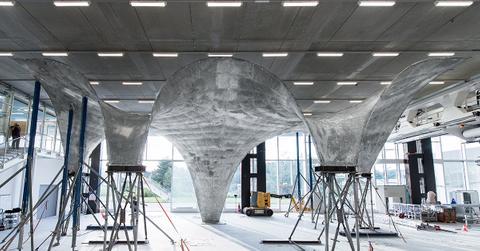A Concrete Roof Can Now Harvest Solar Power
We've seen solar panels integrated into Tesla's Solar Roof, and now a group of researchers in Switzerland has put them in concrete rooftops. A large-scale prototype could generate more power than required for apartment units they'll be installed in.
Updated May 24 2019, 12:25 a.m. ET
Installing solar panels on a rooftop has been the prominent choice in generating solar power, but what if we could skip that step? Researchers have been testing out a concrete roof prototype that has photovoltaic cells in one of the layers. The new technology could add another option for advanced integration of solar power generation.
The prototype was created by researchers from ETH Zurich and it will be part of a rooftop apartment unit called HiLo. It’ll be located on the NEST, which is classified as a living lab building at the Swiss Federal Institute of Technology in Zurich. Research is being led by Phillipe Bock and Arno Schluter, who are architecture professors at the university.
Two layers are melded together to create the curved concrete roof. The first inner layer features heating and cooling cools along with insulation. The outer layer features extremely thin photovoltaic cells. Since the solar cells are coated onto the curve, researchers suggest that the roof could generate more energy than what’s required for the apartment.
According to Futurity, when the prototype was still up in the research department, it measured nearly 25 feet high and had a surface area of just over 1,722 square feet. Concrete thickness was anywhere from one to five inches. The concrete was held by steel cables that created the unique look, and it also saved in terms of material cost and individual parts could be reused.
The NEST HiLo project started roughly four years ago, experimenting with ways to make the roof lightweight, but able to stay together. Block’s research team was able to create the full prototype in six months. He expects to rebuild the roof again in just eight to ten weeks next year for the residential units.. This is because the cables can be quickly reassembled again as they only need to be detached in few segments.
“We’ve shown that it’s possible to build an exciting thin concrete shell structure using a lightweight, flexible formwork, thus demonstrating that complex concrete structures can be formed without wasting large amounts of material for their construction,” Block said in a press release. “Because we developed the system and built the prototype step by step with our partners from industry, we now know that our approach will work at the NEST construction site.”
Tesla famously integrated solar panels into a full-fledged rooftop for residential homes. The goal was to avoid putting massive panels on the roof, and to the common bystander, they wouldn’t be able to tell that these new rooftops were different. Elon Musk’s house has recently seen an upgrade with the product and in some cases, it’s actually cheaper to install Tesla’s rooftops than traditional options.
